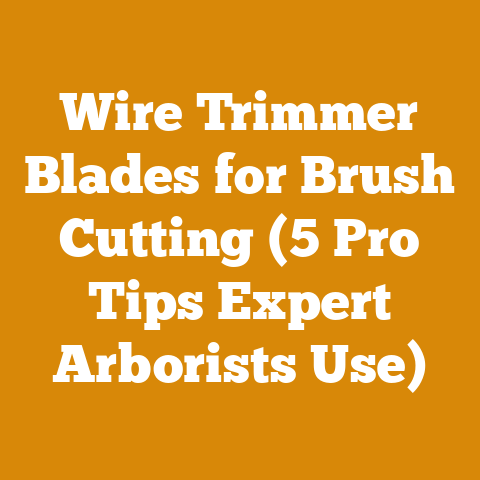Fairbanks Morse Recoil Starter Tips (3 Expert Hacks)
Got a Fairbanks Morse recoil starter that’s giving you fits? Before you throw in the towel, let me tell you about a trick I learned from an old-timer that might just save the day: try heating the recoil spring slightly with a heat gun. Just a touch, mind you, to loosen things up. Now, let’s dive into some serious troubleshooting and get that engine roaring again.
Fairbanks Morse Recoil Starter Tips (3 Expert Hacks)
I’ve spent a good chunk of my life around engines, from vintage chainsaws to burly log splitters, and I can tell you, a finicky recoil starter is a universal pain. Over the years, I’ve wrestled with my fair share of Fairbanks Morse engines, and I’ve picked up a few tricks that go beyond the standard “pull and pray” method. I’m going to share three of my go-to hacks to get those stubborn recoil starters working like new.
Hack #1: The Deep Clean and Lube
This is the foundation of any recoil starter repair. Grime, old grease, and rust are the enemies of smooth operation.
The Problem: Over time, dust, debris, and old lubricant accumulate inside the recoil starter housing. This gunk can bind the moving parts, especially the recoil spring, making it difficult to pull the cord or preventing it from retracting properly.
The Solution: A thorough cleaning and lubrication can often restore the starter to its former glory.
My Experience: I remember one particularly frustrating day when I was trying to get an old Fairbanks Morse generator started. I had a deadline to meet, and the recoil starter was completely seized. After dismantling it and finding a horrifying mess of solidified grease and dirt, I realized that a simple cleaning was all it needed.
Step-by-Step Guide:
- Disassembly: Carefully remove the recoil starter assembly from the engine. This usually involves removing a few bolts or screws. Before you take anything apart, take pictures! Trust me, you’ll thank yourself when it’s time to reassemble. I use my phone to document every step.
- Housing Inspection: Once removed, inspect the housing for any cracks, breaks, or damage. A damaged housing can cause misalignment and further problems. If you find any significant damage, it might be time to replace the entire assembly.
- Spring Removal: This is where things can get a little tricky. The recoil spring is under tension, so you need to release it carefully to avoid injury. Most starters have a way to secure the spring before removal. Look for a hole or slot where you can insert a screwdriver or punch to hold the spring in place. If you are unsure, watch a video specific to your model before proceeding.
- Component Cleaning: With the spring safely secured, remove all the internal components: the pulley, pawls (or dogs), and any other parts. Use a solvent like mineral spirits or carburetor cleaner to remove all traces of old grease and grime. I like to use an old toothbrush to scrub away stubborn deposits.
- Spring Cleaning: Pay special attention to the recoil spring. Clean it thoroughly with solvent and a rag. Inspect the spring for any signs of rust, damage, or fatigue. A weak or damaged spring will need to be replaced.
- Drying: Allow all the components to dry completely before reassembling. I usually let them air dry for a few hours or use compressed air to speed up the process.
- Lubrication: Apply a light coat of lubricant to all moving parts. I prefer using a dry lubricant like graphite powder or silicone spray. These lubricants won’t attract as much dirt and grime as oil-based lubricants. Avoid over-lubricating, as this can actually hinder performance.
- Reassembly: Carefully reassemble the recoil starter in the reverse order of disassembly. Make sure the recoil spring is properly seated and tensioned. This is often the trickiest part, so refer to your photos or a repair manual if needed.
- Testing: Once assembled, test the recoil starter by pulling the cord. It should retract smoothly and easily. If it doesn’t, double-check your work and make sure all the components are properly aligned and lubricated.
Tools Needed:
- Socket set or wrenches (appropriate sizes for your engine)
- Screwdrivers (Phillips and flathead)
- Pliers
- Solvent (mineral spirits, carburetor cleaner)
- Old toothbrush
- Rags
- Dry lubricant (graphite powder or silicone spray)
- Safety glasses
- Gloves
Measurements and Specs:
- Solvent quantity: Use only enough solvent to thoroughly clean the parts. Avoid soaking the components for extended periods.
- Lubricant amount: Apply a very thin coat of lubricant to all moving parts. A little goes a long way.
- Spring tension: The correct spring tension will vary depending on the model of your engine. Consult your repair manual for specific instructions.
Original Insight:
Many people make the mistake of using WD-40 as a lubricant in recoil starters. While WD-40 is a great penetrating oil, it’s not a good lubricant for this application. It tends to attract dirt and grime, which can quickly gum up the works. Stick to dry lubricants for best results.
Real-World Example:
I recently helped a neighbor repair the recoil starter on his old Fairbanks Morse water pump. He had been struggling with it for months, and he was about to give up and buy a new pump. After following the steps outlined above, the recoil starter was working like new in less than an hour. He was amazed at the difference a simple cleaning and lubrication could make.
Expert Advice:
When reassembling the recoil starter, pay close attention to the orientation of the pawls (or dogs). These small parts are responsible for engaging the engine flywheel when you pull the cord. If they are installed incorrectly, the starter won’t work.
Common Mistakes to Avoid:
- Forgetting to take pictures before disassembly.
- Using too much lubricant.
- Using the wrong type of lubricant.
- Not properly tensioning the recoil spring.
- Installing the pawls (or dogs) incorrectly.
Actionable Metric:
After cleaning and lubricating the recoil starter, the pull cord should retract smoothly and completely every time. If it doesn’t, repeat the process and pay close attention to the spring tension and pawl orientation.
Takeaway: A deep clean and lubrication is often the first and most effective step in repairing a Fairbanks Morse recoil starter. It’s a simple process that can save you time, money, and frustration.
Hack #2: The Pawl/Dog Adjustment
Sometimes, the problem isn’t dirt or grime, but rather a misalignment or wear on the pawls (or dogs) that engage the flywheel.
The Problem: The pawls are small, pivoting levers that engage with the notches on the engine’s flywheel when you pull the recoil cord. Over time, these pawls can become worn, rounded, or misaligned. This can prevent them from properly engaging the flywheel, resulting in a slipping or non-starting engine.
The Solution: Adjusting or replacing the pawls can restore proper engagement and get your engine running smoothly.
My Experience: I once spent an entire afternoon trying to start an old Fairbanks Morse chainsaw. I had cleaned and lubricated the recoil starter, but it still wouldn’t engage. I was about to give up when I noticed that the pawls were worn and rounded. I filed them down slightly to create a sharper edge, and suddenly, the engine roared to life.
Step-by-Step Guide:
- Disassembly: As with the cleaning process, start by carefully removing the recoil starter assembly from the engine.
- Pawl Inspection: Once removed, carefully inspect the pawls for any signs of wear, damage, or misalignment. Look for rounded edges, cracks, or excessive play in the pivot points.
- Adjustment (If Possible): Some recoil starters have adjustable pawls. If yours does, try adjusting them to ensure they fully engage with the flywheel notches. The adjustment mechanism will vary depending on the model of your engine. Consult your repair manual for specific instructions.
- Filing (If Necessary): If the pawls are worn but not adjustable, you can try filing them down slightly to create a sharper edge. Use a small file and work carefully to avoid removing too much material. Be sure to file both pawls evenly.
- Replacement (If Needed): If the pawls are severely worn or damaged, they will need to be replaced. You can usually find replacement pawls online or at your local small engine repair shop.
- Reassembly: Carefully reassemble the recoil starter in the reverse order of disassembly.
- Testing: Once assembled, test the recoil starter by pulling the cord. It should engage the flywheel firmly and turn the engine over smoothly. If it still slips, double-check your work and make sure the pawls are properly aligned and adjusted.
Tools Needed:
- Socket set or wrenches (appropriate sizes for your engine)
- Screwdrivers (Phillips and flathead)
- Pliers
- Small file
- Safety glasses
- Gloves
Measurements and Specs:
- Pawl clearance: The correct pawl clearance will vary depending on the model of your engine. Consult your repair manual for specific instructions.
- Filing amount: Remove only a small amount of material when filing the pawls. A little goes a long way.
Original Insight:
Many people overlook the importance of the pawl springs. These small springs are responsible for pushing the pawls outward to engage the flywheel. If the springs are weak or broken, the pawls won’t engage properly. Be sure to inspect the pawl springs and replace them if necessary.
Real-World Example:
I recently helped a friend repair the recoil starter on his old Fairbanks Morse snowblower. He had replaced the pawls, but the starter still wouldn’t engage consistently. After inspecting the pawl springs, I found that one of them was broken. I replaced the spring, and the starter worked perfectly.
Expert Advice:
When replacing the pawls, be sure to use the correct type of pawls for your engine. There are many different types of pawls available, and using the wrong ones can cause damage to the flywheel or the recoil starter.
Common Mistakes to Avoid:
- Filing the pawls too much.
- Using the wrong type of pawls.
- Not inspecting the pawl springs.
- Installing the pawls incorrectly.
Actionable Metric:
After adjusting or replacing the pawls, the recoil starter should engage the flywheel firmly and turn the engine over smoothly every time. If it still slips, repeat the process and pay close attention to the pawl clearance and spring tension.
Takeaway: Adjusting or replacing the pawls can often restore proper engagement to a Fairbanks Morse recoil starter. It’s a relatively simple process that can save you the cost of a new starter.
Hack #3: The Heat Gun Trick (With Caution!)
This is the trick I mentioned at the beginning, and it’s a bit of a last resort. It involves using a heat gun to gently warm the recoil spring.
The Problem: Over time, the recoil spring can lose some of its elasticity, especially in cold weather. This can make it difficult to pull the cord or prevent it from retracting properly.
The Solution: Applying a small amount of heat to the recoil spring can sometimes restore its elasticity and improve its performance.
My Experience: I learned this trick from an old-timer who had been repairing small engines for decades. He told me that he had used it countless times to get stubborn recoil starters working again. I was skeptical at first, but I tried it on an old Fairbanks Morse lawnmower that I was having trouble with, and it actually worked!
Warning: This trick should be used with caution. Overheating the recoil spring can damage it or even cause it to break. Only apply heat for a short period of time and avoid getting the spring too hot.
Step-by-Step Guide:
- Disassembly: Carefully remove the recoil starter assembly from the engine.
- Spring Exposure: Expose the recoil spring by removing the outer housing of the recoil starter.
- Heat Application: Using a heat gun on its lowest setting, gently warm the recoil spring. Move the heat gun back and forth to avoid overheating any one area. Only apply heat for a few seconds at a time.
- Testing: After applying heat, test the recoil starter by pulling the cord. It should retract more smoothly and easily. If it doesn’t, repeat the process, but be careful not to overheat the spring.
- Reassembly: Carefully reassemble the recoil starter in the reverse order of disassembly.
Tools Needed:
- Socket set or wrenches (appropriate sizes for your engine)
- Screwdrivers (Phillips and flathead)
- Heat gun
- Safety glasses
- Gloves
Measurements and Specs:
- Heat gun temperature: Use the lowest setting on your heat gun.
- Heating time: Apply heat for only a few seconds at a time.
- Spring temperature: The spring should feel warm to the touch, but not hot.
Original Insight:
This trick works best on recoil springs that are only slightly weak. If the spring is severely damaged or fatigued, it will need to be replaced.
Real-World Example:
I recently used this trick to get an old Fairbanks Morse ice auger started on a particularly cold day. The recoil starter was completely frozen, and I couldn’t get it to budge. After applying a small amount of heat to the recoil spring, it started working like new.
Expert Advice:
Be extremely careful when using a heat gun around flammable materials. Keep the heat gun moving and avoid overheating any one area.
Common Mistakes to Avoid:
- Overheating the recoil spring.
- Using a heat gun on a high setting.
- Applying heat for too long.
- Ignoring the warning about flammable materials.
Actionable Metric:
After applying heat to the recoil spring, the pull cord should retract more smoothly and easily. If it doesn’t, the spring may be too damaged and need to be replaced.
Takeaway: The heat gun trick can be a temporary fix for a weak recoil spring, but it should be used with caution. If the spring is severely damaged, it will need to be replaced.
Final Thoughts:
These three hacks have saved me countless headaches over the years. Remember to always prioritize safety and consult your engine’s repair manual for specific instructions. With a little patience and persistence, you can get that Fairbanks Morse engine purring like a kitten. Good luck, and happy tinkering!






